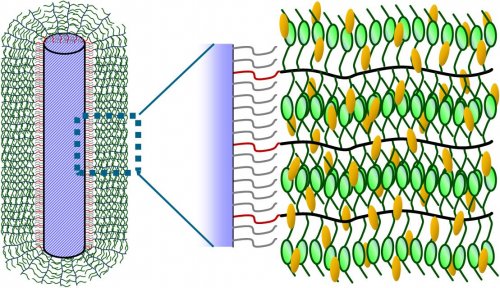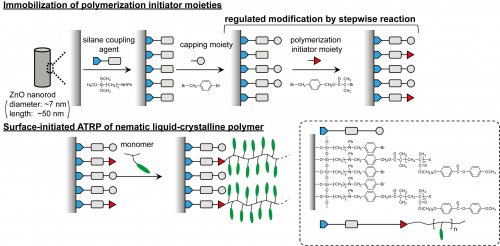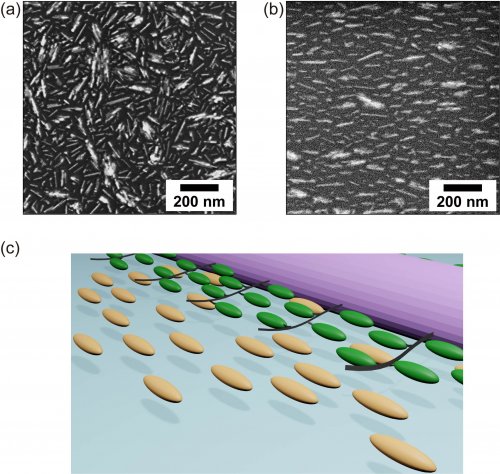Latest Research
- 2020.12.14
- Shishido-Kubo Group
Unidirectional alignment of inorganic nanorods by the orientation of liquid crystals
Inorganic nanocrystals are well known to exhibit peculiar anisotropic properties quite different from bulk materials. Especially nanorods have attracted great attention due to the promising application to anisotropic functional materials. It is indispensable to regulate the alignment of nanorods to utilize their anisotropic properties. So far, it has been attempted to control the orientation of nanorods by various methods such as electric field, self-assembly, incorporation into polymers, and so on. However, the unidirectional and uniform alignment of nanorods over a large area sill remains a challenge. Here we propose the methods for achieving unidirectional alignment of nanrods assisted by molecular orientation of liquid crystals. We designed hybrid materials of inorganic nanorods and liquid crystals, where nanorods modified with liquid-crystalline polymers were cooperated with liquid-crystalline small molecules (Fig. 1).[1]
 Figure. 1. Schematic illustration of inorganic nanorods hybridized with liquid crystals.
Figure. 1. Schematic illustration of inorganic nanorods hybridized with liquid crystals.
Surfacemodification of nanorods with liquid-crystalline polymers were conducted as shown in Fig. 2. Polymerization initiator moieties were immobilized onto the surface of ZnO nanorods (average diameter 7 nm; length 50 nm). The modification density of the initiator moieties (dI) was regulated by the step-wise reaction with the capping and initiator moieties. Nematic liquid-crystalline polymers were grafted from the polymerization initiators on the nanorod surfaces by atom transfer radical polymerization (ATRP).
 Figure 2. Synthetic scheme of ZnO nanorods modified with nematic liquid-crystalline polymers.
Figure 2. Synthetic scheme of ZnO nanorods modified with nematic liquid-crystalline polymers.
The surface-modified ZnO nanorods accompanied with liquid-crystalline small molecules were spincoated on a Si substrate coated with a polyimide alignment layer, and annealed at the temperature exhibiting a nematic phase. Interestingly, unidirectional alignment of nanorods were induced only in the presence of liquid-crystalline small molecules (Fig. 3a,b). Furthermore, the surface-modification density had a great influence on the alignment of nanorods. The appropriate surface modification with nematic liquid-crystalline polymers enabled the cooperation of polymers and small molecules, resulting in the unidirectional alignment of nanorods along the molecular alignment of liquid crystals. (Fig. 3c)
 Figure 3. (a, b) Scanning electron microscope images of surface-modified ZnO nanorods in the absence (a) and in the presence (b) of liquid-crystalline small molecules. (c) Schematic illustration of the alignment of surface-modified nanorods along the molecular orientation of liquid crystals.
Figure 3. (a, b) Scanning electron microscope images of surface-modified ZnO nanorods in the absence (a) and in the presence (b) of liquid-crystalline small molecules. (c) Schematic illustration of the alignment of surface-modified nanorods along the molecular orientation of liquid crystals.
In summary we proposed a material design to condut the molecular orientation of liquid crystals to inorganic nanorods. The presented method is applicable to other kinds of materials in principle. We are also carring out related researches: the desgin of liquid-crystalline polymers to improve the formation of organized structures and the study of molecular motions at the interface between polymer films and substrate surfaces.[2,3] The development of anisotropically functional materials will be presented in the future research.
References
| [1] | S. Kubo, R. Taguchi, S. Hadano, M. Narita, O. Watanabe, T. Iyoda, M. Nakagawa, ACS Appl. Mater. Interfaces 2014, 6, 811-818. |
| [2] | T. Sodemura, S. Kubo, H. Higuchi, H. Kikuchi, M. Nakagawa, Bull. Chem. Soc. Jpn. 2017, 90, 216-222. |
| [3] | S. Kubo, M. Kumagai, N. Kawatsuki, M. Nakagawa, Langmuir 2019, 35, 14222-14229. |



